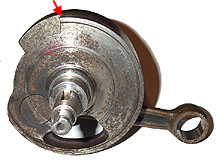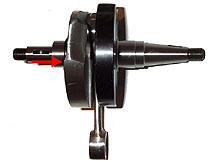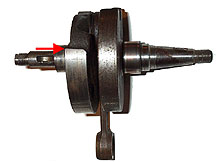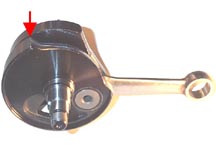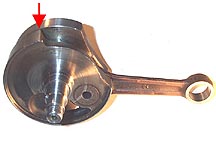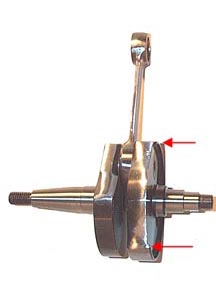Vespa Crank Modifications
This is a very basic guide - A Vespa
crankshaft differs from a Lambretta because part of the crank controls
the induction of the gasoline/air mix into the crankcase. On the clutch
side engine casing there is an intake hole directly below the carb.
This passes through the casing into the crankcase and the interior face
of the hole is perfectly machined to fit against the circular clutch
side crank web. Part of the clutch side crank web is machined away from
the circumference of the rest of the crank half. This means that as
this area rotates under the induction hole, it becomes open and at the
same time the piston is rising up, creating a vacuum in the crankcase.
Gasoline is sucked into the crankcase because of this vacuum. To a
point, the longer the crankcase valve is open, the more gasoline/air
the engine can suck in.
Below is a model of a P-series crank
showing the machined clutch side crank web nearest to you, and the
point where it has been machined down to allow gasoline to be sucked
through from the carb. You can see this web is perfectly circular
except for the cut out just above the crank pin.
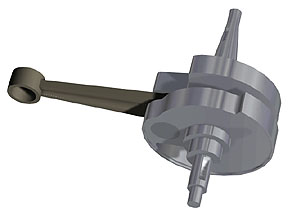
When people talk about having a "cut
crank" they are referring to machining this cut out to have less of the
circular crank edge and more of the opening which allows the carb
intake to be open for a longer period of time in every rotation. This
intake time is measured in degrees.
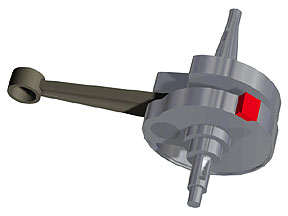
The red area above is the area which
could be removed from an existing crank. This involves having your
crank split by a motorcycle/scooter shop because there is no way to
protect the main con rod bearing from all the waste metal that will be
ground out.
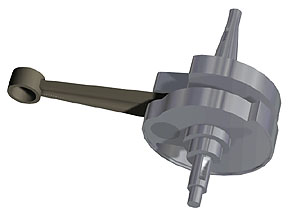
Many manufacturers of aftermarket cranks
sell cranks with an opening that is machined to allow the intake to be
open for more degrees of rotation. A standard crank is open for about
155 degrees of the 360 degree revolution. A heavily modified crank can
be open for as much as 200 degrees. If the crank is opened up too much
you will allow either the piston to be coming down when the valve is
open which will force all the gasoline/air back out the intake (your
motor won't run) or in the other direction, the transfers may be open
at the same time as the inlet which is also a bad thing.
Above are shots of a Mazzuchelli crank
we bought for a Malossi P210 motor on the left and a standard 200cc (in
sad shape) crank on the right. On both cranks the inlet opening is at
the same point near the big end pin. The Mazzuchelli crank comes
already cut to allow for a longer inlet period as noted with the small
red arrow. Some other small differences are the shape of the intake lip
is angled on the cut crank, the window in the clutch side is smaller,
and the crank surfaces have been polished for gas flow. Click on images
for a larger view. Below are images of a small frame crank with the
same treatment.
|











